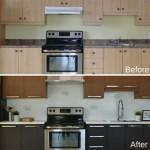Restoring the Beauty of Golden Oak Kitchen Cabinets: A Comprehensive Guide
Golden oak kitchen cabinets exude a timeless charm that complements both traditional and modern design aesthetics. However, over time, the natural patina of these cabinets can fade or become marred by scratches and stains. Restoring their original luster requires a meticulous approach that involves careful preparation, selection of appropriate products, and skilled application techniques.
1. Preparation: The Foundation for a Flawless Finish
Before applying any stain, it is crucial to thoroughly clean and sand the cabinets. Use a mild detergent solution to remove any grime or grease, then lightly sand the surface with fine-grit sandpaper to create a smooth and receptive base for the stain.
If the cabinets have any areas of damage or deep scratches, fill them with a wood filler that matches the color and grain of the oak. Allow the filler to dry completely before sanding the surface flush with the surrounding wood.
2. Choosing the Right Stain: Capturing the Desired Color
The choice of stain will determine the final color and tone of the cabinets. For golden oak, select a stain that contains yellow, amber, or orange undertones. Test the stain on an inconspicuous area of the cabinet to ensure that the color matches your desired outcome.
If you want to intensify the golden hue, apply two or more coats of stain, allowing each coat to dry completely before applying the next. For a more subtle effect, apply a single coat of stain and finish with a clear sealant.
3. Application Techniques: Precision and Patience
When applying the stain, use a brush or foam applicator that will evenly distribute the pigment without leaving streaks or brush marks. Apply the stain in the direction of the wood grain, using long, even strokes.
Allow the stain to penetrate the wood for the recommended time, as indicated on the product label. Wipe off any excess stain with a clean cloth, paying special attention to the edges and corners of the cabinets.
4. Sealing the Finish: Protecting Your Investment
Once the stain has dried completely, it is essential to seal the finish to protect it from wear and tear. Opt for a clear sealant that is specifically designed for kitchen cabinets, as it will provide a durable and moisture-resistant barrier.
Apply the sealant in thin, even coats, using the same brush or applicator as the stain. Allow each coat to dry completely before applying the next, and follow the manufacturer's instructions for the recommended number of coats.
5. Finishing Touches: Enhancing the Detail
To complete the restoration, consider adding finishing touches that will enhance the overall look of the cabinets. Replace any outdated hardware with new pulls or knobs that complement the golden oak finish.
If desired, you can apply a glaze over the stain to add depth and richness. Glazes are typically available in various colors, such as brown, black, or amber, and can be applied with a brush or cloth.
By following these steps carefully, you can restore the golden oak kitchen cabinets to their former glory, enhancing the beauty and functionality of your kitchen for years to come. Remember to exercise patience throughout the process, as it takes time and attention to detail to achieve a professional-looking finish.
Refinishing Golden Oak Cabinets Pinnacle Homes Inc

Honey Oak Cabinets Restained With Genera Finishes American Gel Stain Are Just A Kitchen Remodel Stained

How I Updated My Oak Cabinets Without Paint By Using Briwax Easy Budget Kitchen Makeover Only 24

From To Great A Tale Of Painting Oak Cabinets

Tips Tricks To Paint Honey Oak Kitchen Cabinets Cottage Living And Style

Staining Your Wood Cabinets Darker Young House Love

Tips And Ideas How To Update Oak Or Wood Cabinets Paint Stain More

How To Work With Your Honey Oak Cabinets And Trim Carla Bast Design
How To Work With Your Honey Oak Cabinets And Trim Carla Bast Design

How To Stain Dark Or Yellow Kitchen Cabinets Lighter
Related Posts








